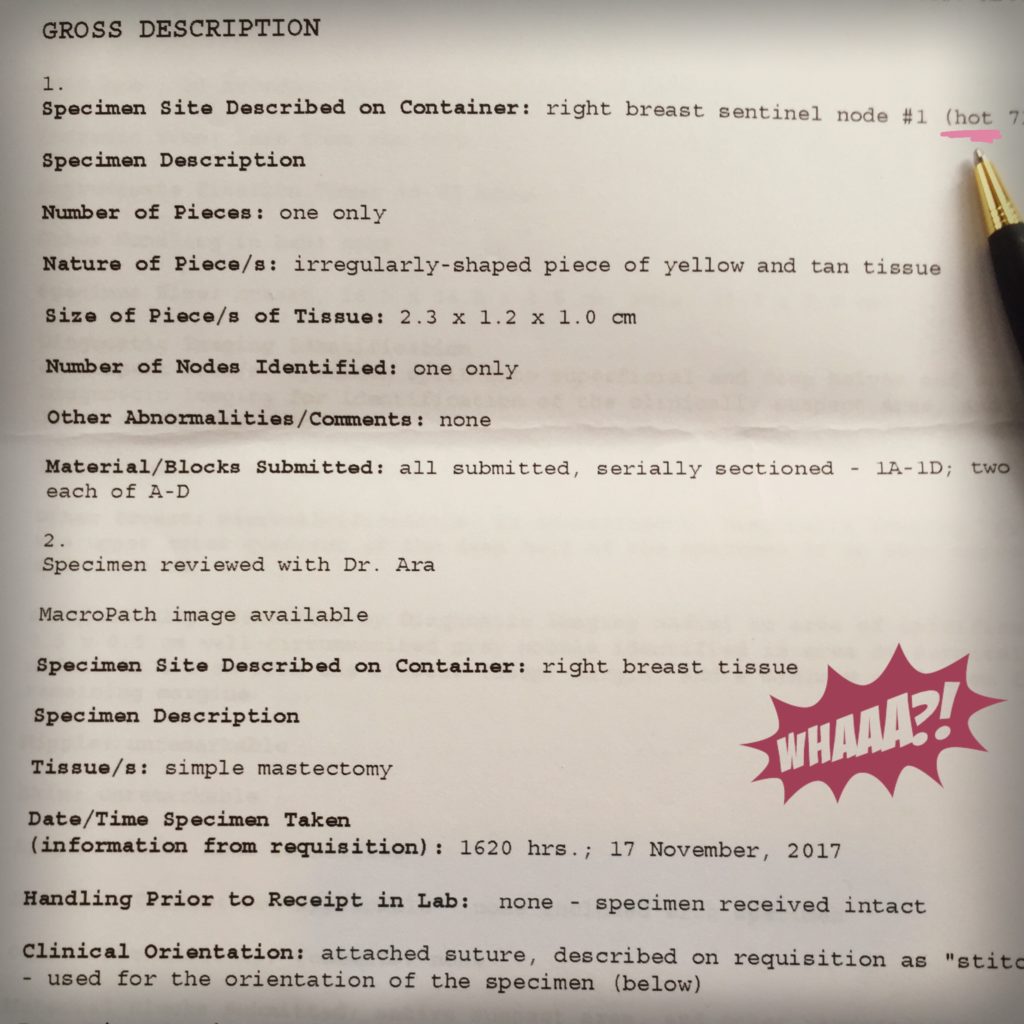When looking for signs of malignancy in a pathology report, a negative result is a good thing. A positive result is a bad thing. My biopsy was positive for cancer. Bad. Treatment? Take it out. Done.
This week I received the first pathology report that gave data on 3 things that were removed during surgery: Lymph Nodes, Right Breast and Left Breast. Since I knew that the Right Breast contained cancer cells, it wasn’t expecting any huge surprises, just more details. The Left Breast was removed prophylactically (for my convenience) so I wasn’t expecting anything there. But the Lymph Nodes? Now that data was going to be important.

Such great news! Negative! Woot Woot!
Before we go too far along, let me explain a bit about the lymphatic system – that will give you an idea of why this is such a big fucking deal.
The lymphatic system carries lymph – a clear fluid (from Latin lympha, meaning water). Lymph works in conjunction with the circulatory system (which carries blood). It travels along and filters through lymph nodes (we have between 500 and 600 in our bodies). Here’s a look at the area of interest to me:

Lymph nodes and the lymphatic system are very important in the cancer world, because when you have cancer, the lymphatic system acts as a highway (to hell). It carries cancer cells all over the body where it can take root, grow and kill you. That process is called metastasis. I’m sure you’ve heard of metastatic cancer. Sucks.
When cancer cells travel in lymph, they will get caught up in the lymph nodes. This is why, when looking for any spread of cancer, the surgeon first figures out which nodes the cancer tumor drains to, and then does a biopsy of those nodes. With breast cancer the surgeon takes out one or more axillary lymph nodes. They are in the armpit as you see in the diagram above. In an earlier post I told you a bit about how I was prepped for the sentinel node biopsy. I found out later that only one node “lit up”, which was a good thing since the surgeon only had to take one out.

Of course, since it’s deep in the armpit, the surgery involves digging and scraping through the pectoral muscle so it’s a bit tender. But I digress. My “hot” node was negative, and that’s what’s important. No cancer in my lymphatic system. Phew!
The second set of results were details about the cancer in the right breast – which we knew a bit about already, mainly that it was Ductal Carcinoma in Situ (DCIS) with microinvasions. That means that there was cancer in the duct with some invading out of the duct. Details from the pathology report:
- the cells are Stage 3 invasive ductal carcinoma
- there were multiple foci of microinvasion in the 4cm x 3.6cm area (as shown in the MRI … so mastectomy was the right call). 🙂
- the two foci were 2.5mm and 2.1 mm
- there were clear margins around the larger area
- It is named “high grade comedonecrosis” or “Grade 3”, positive for EIC (extensive intraductal component) Which translates roughly to “really fucking bad”, as my surgeon pretty nearly said, but without the swearing.

The data revealed that it was bloody good that they did a mastectomy, rather than a partial mastectomy (otherwise known as a lumpectomy). It was a bit of a crap shoot to do it since MRI results can often be a “false positive”. I decided to err on the side of caution and had both breasts removed. Glad I did.
Next step is to meet my oncologist. He / she will read the next pathology report that identifies my cancer cells’ receptors. These receptors indicate what makes my cancer cells grow, and so from that, they determine the treatment plan. But that’s for another blog post.
Thanks for hanging in!
